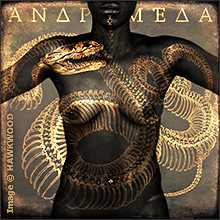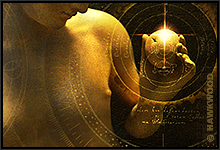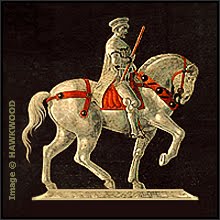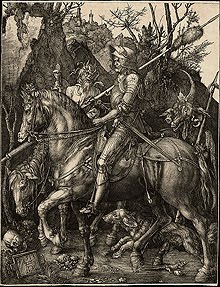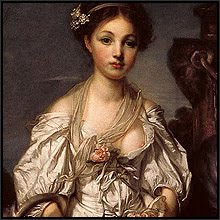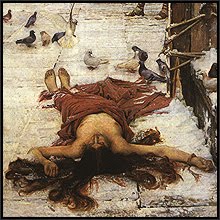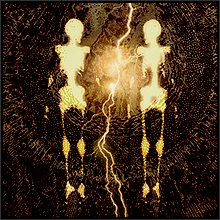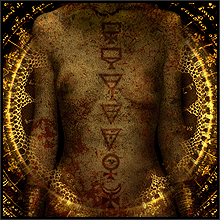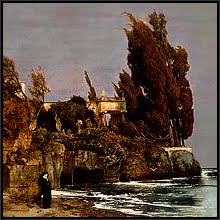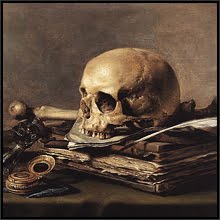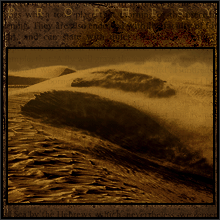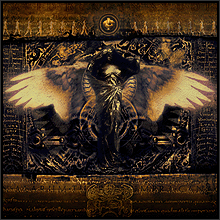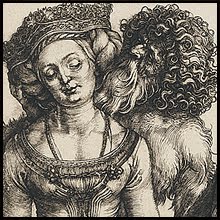He stands like some 18th-century captain-explorer at the prow of his ship, his eyes shaded from the glare of the fierce tropic sun as he voyages on towards uncharted horizons (below). It is the gesture of shading his eyes that makes this self-portrait by Sir Joshua Reynolds so daringly unique, and he leaves us wondering. Was this a simple natural gesture, betraying the fact that he was bothered by the direct sunlight streaming through his studio window, and making it difficult for him accurately to gauge the exact colours on his palette? Or was this the way in which he consciously wished to portray himself, searching for a landfall on some undiscovered shore of art?
If the latter, then Reynolds was navigating treacherous shoals. His flair for experimenting with concocting his own oil paints was very much a hit-and-miss affair. 'Mix a little wax with your colours,' he is reputed to have advised a student, 'but don't tell anybody.' Within his own lifetime, he saw his own paintings crack with the brittleness of the unstable pigments which he used. 'All good paintings crack.' was his typically spry response.
This self-portrait in pastels by Jean-Baptiste-Simeon Chardin (below) has long been one of my favourite self-portraits by an artist. We easily can imagine Chardin working quietly and alone in his studio, intensely observing his own likeness in a looking-glass, then briefly focusing back towards his easel as, step by step, he transmuted his own features into art. A hint of quizzical enquiry plays around the upturned corners of his mouth: a self-regard which is also a self-awareness of his involvement in the task to which he has committed himself.
Here in the interior of his studio, his fashionable wig has been replaced in favour of a comfortable white scarf secured in place by a blue headband. In this self-portrait he makes us, his audience, privilege to his informal dress. We see Chardin as he saw himself in the privacy of his own house, and not as we would see him had we encountered him on the street. The pink and blue neckerchief, the steel-rimmed pince-nez perched upon his nose, all combine to underscore the informal humanity of the artist himself. When I look at this self-portrait I find myself thinking: yes - Chardin was someone whom I would like to have met and talked with. He was, I am sure, a decent and likeable person.
As does Reynolds, Chardin provides himself with a neutral dark background - common-enough to be seen in portraits of his time. And he plays the harmonics of his colour palette throughout this work, dragging the pinks and blues of what he is wearing through his own features. Seeing this portrait in our own time, it is difficult to appreciate just how cutting-edge Chardin's techniques were. His method of using hatched lines of pure colour (the detail, above) in such a way that the eye of the observer mixes them together from a distance was revolutionary for its time. More than two centuries later, I have used this identical technique when I have worked with pastels, and I owe it to Chardin's groundbreaking originality.
Fast-forward exactly one hundred and one years on from the affable originality of Chardin's self-portrait. The neutral background darkness is still there, but what a different world we find ourselves in. The Swiss symbolist Arnold Böcklin presents his likeness to us (above), but his is not the only presence which we see: the all-too-real face of Death emerges from the shadows over the artist's left shoulder. But this visible horror seems to leave the artist unmoved; he even inclines his head towards the grim figure, almost in a gesture of familiarity. Death the fiddler calls the tune, and Böcklin, unphased, calmy paints along.
Death here might be portrayed as tangibly as Albrecht Dürer's figure of Death of almost four centuries before (see this blog's header), but there is no gothic grimness in this self-portrait. How could there be, when the overwhelming feeling is one of reconciliation, of an awareness of death as being simply a part of the scheme of things, as real and as necessary to the scene as the artist's own palette and brush which he holds. Death cannot be defeated, but it can be accepted. That is what Böcklin shows, and this simple realisation is his triumph.
HawkwoodOn Sir Joshua Reynolds: Charlotte J. Blennerhassett: Sidelights
On Jean-Baptiste-Simeon Chardin: Geneviéve Monnier: Le Pastel
On Arnold Böcklin: Ursula Bode: Kunst zwischen Traum und Alptraum
Artist: Sir Joshua Reynolds
Work: Self-portrait, 1747
Medium: Oils
Location: National Gallery, London
Artist: Jean-Baptiste-Simeon Chardin
Work: Self-portrait, 1771
Medium: Pastels
Location: Louvre, Paris
Artist: Arnold Böcklin
Work: Self-portrait with Fiddling Death, 1872
Medium: Oils
Location: National Gallery, Berlin



